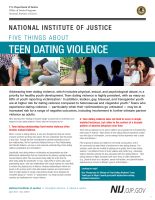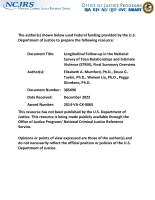Youth development
Longitudinal Follow-up in the National Survey of Teen Relationships and Intimate Violence (STRiV), Final Summary Overview
ABCD Social Development (ABCD-SD)
How Do “Credible Messenger” Mentors Promote Youth Development? A Retrospective, Longitudinal Study in Atlanta, Birmingham, and Houston
Exploring mentor practices using data from OJJDP’s Mentoring Enhancement Demonstration Program
Building Adult Social and Emotional Capacity: A Key Ingredient for Unleashing the Power of Prevention
A Cluster Randomized Controlled Trial of the Safe Public Spaces in Schools Program: Final Summary Overview
Preventing Teen Pregnancy and Academic Failure: Experimental Evaluation of a Developmentally Based Approach
Honor, face, and dignity norm endorsement among diverse North American adolescents: Development of a Social Norms Survey
School Transitions and Student Responses to Victimization - Breakout Session, NIJ Virtual Conference on School Safety
On February 16-18, 2021, the National Institute of Justice hosted the Virtual Conference on School Safety: Bridging Research to Practice to Safeguard Our Schools. This video includes the following presentations:
See the YouTube Terms of Service and Google Privacy Policy
Multi-Component Efforts to Improve School Safety - Breakout Session, NIJ Virtual Conference on School Safety
On February 16-18, 2021, the National Institute of Justice hosted the Virtual Conference on School Safety: Bridging Research to Practice to Safeguard Our Schools. This video includes the following presentations:
See the YouTube Terms of Service and Google Privacy Policy
Overcoming School Safety Intervention Implementation Challenges - Breakout Session, NIJ Virtual Conference on School Safety
On February 16-18, 2021, the National Institute of Justice hosted the Virtual Conference on School Safety: Bridging Research to Practice to Safeguard Our Schools. This video includes the following presentations:
See the YouTube Terms of Service and Google Privacy Policy
Addressing Student Mental Health Concerns - Breakout Session, NIJ Virtual Conference on School Safety
On February 16-18, 2021, the National Institute of Justice hosted the Virtual Conference on School Safety: Bridging Research to Practice to Safeguard Our Schools. This video includes the following presentations:
See the YouTube Terms of Service and Google Privacy Policy





